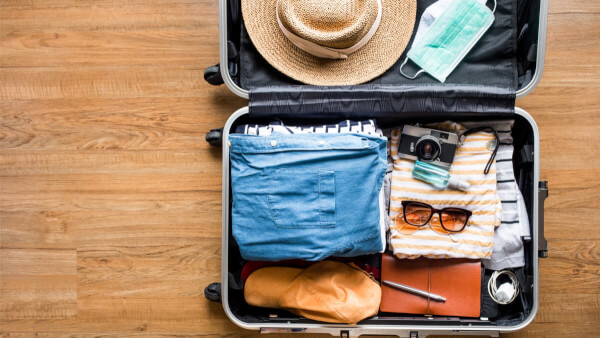Complete Guide to ING International ATM Fees: Withdrawal Fee, Exchange Rates and Rebates
Planning to use your UBank card to make ATM withdrawals internationally? Read on to understand the true cost of overseas transactions with UBank.

The prepaid travel card market has become a vibrant and competitive one, and Qantas was a natural addition to the industry. The brand itself has earned its stellar reputation as Australia’s flagship carrier, and its prepaid offering has secured a position on the Canstar list. The card allows you to earn frequent flyer points when you shop at the millions of global merchants who accept Mastercard. If you’re planning an international jaunt, this card supports a wide range of currencies, all of which can be kept on a single card. Qantas' card gives you easy access to your funds while you’re on foreign soil. You can expect no card loading or conversion fees, and top-ups are easily achieved online. The card gives you a single locked exchange rate, which can protect you from fluctuations in the market.
Qantas offer a travel money card, which is confusingly called “Qantas Cash” and it functions in much the same way as other travel money providers, letting you shop online or off and top up your funds digitally. When you need cash, you can withdraw from your Qantas card at ATMs that support Mastercard. There are few limitations here. You can transfer funds up to a limit of $20,000 daily or $100,000 annually. Withdrawals are limited to $3,000 a day, and card transactions are capped at $15,000.
Qantas Cash is a prepaid card that bolsters your security in ways that traditional Travellers' cheques simply can’t, bringing the regular level of security that you get with a debit card to your spending while locking currency exchange rates. The system is flexible. You can set aside a defined amount of each currency, but if you overspend on one, Qantas will simply draw from another currency. You can withdraw from ATMs displaying the Maestro, Mastercard or Cirrus sign, and each $1 you spend will earn 1.5 frequent flier points. The smartphone app supports your transactions by letting you check your balances and transaction history. The system is focused on prepaid and online transactions, so Qantas does not allow clients to order foreign currency in cash. However, the app lets you create currency wallets that allow for cash withdrawals at ATMs. This is a more convenient and economical way to manage your holiday money. A specialist credit card, for example, would set you back around 3% per transaction in addition to withdrawal fees and interest charges.
Qantas Travel Card doesn’t support all currencies though. You may load a maximum of 11 currencies including USD, GBP, Euros, NZD, Thai Baht, Singapore, Canadian and Hong Kong dollars, Yen, and Dirham.
Qantas has built a partnership with American Express, allowing these clients to earn points on every dollar spent. Bonus status credits, flight vouchers, and travel credit are offered via over 30 different credit card reward bundles.
Travellers' cheques follow many of the same rules as cash does. They can be stolen and spent, and while they place exchange rate risk firmly on the shoulders of their issuer, they lack the flexibility of prepaid cards and multi-currency accounts. If you’re travelling to a remote destination, finding retailers who accepts them can be challenging. That said, they can be exchanged for local currency free of charge, and if you’re visiting less developed destinations, they’re sometimes more versatile than credit and debit cards. This is why they're still used despite the many more technologically advanced travel money options on the market today.
When you compare travel cards, you will find a massive range of fee structures, and this is where Qantas' card shines. The card is issued for free and doesn’t charge fees for bank transfer top-ups. Direct debits have a nominal fee of 0.5%, and currency withdrawals cost AUD 1.95 or €1.5. There are no cash-out or card-to-card transfer fees. In comparison, a typical other big brand charges US$9.95 in start-up fees, $5 for top-ups, and US$2.5 for ATM withdrawals. Qantas’ card is decidedly light on costs in comparison to travellers’ cheques, too, which cost between 1 and 3% of the purchase amount. Unlike travellers’ cheques, Qantas’ card is protected by a PIN.
Qantas’ exchange rates are variable, generally offering close to, and often above, the spot rates determined at the time you top up. A 3% FX markup is charged on top of the market rate. Exchange rates are determined daily by
Qantas. In other words, they offer no transparency, but if you need a reliable estimate, the MasterCard currency conversions page is an excellent guide. Alternatively, visit Qantas’ exchange rates page to compare travel money cards.
When you compare travel cards, you’ll find two broad categories: prepaid and travel credit cards. Canstar’s top rated prepaid cards are ANZ, HSBC, Travelex, and Global Currency Card. Of these, only Travelex and ANZ charge currency conversion fees. Qantas’ number of currencies is higher than all the other ranked rivals, which support five to 10. None charge initial card loading fees. Travel credit cards are known for their flexibility and security, with prepaid offerings giving budgeting travellers a more affordable option.
Wise Borderless accounts are around eight times cheaper than traditional bank accounts and come with the extra security of FCA regulation. These are two of many reasons Transferwise is attracting the attention of big names like Bloomberg and the Financial Times. You receive instant global banking in over 30 countries. Your Australian, New Zealand, British, European, and US account details keep you in the green with truely local details while supporting payments from Eurozone, Australia, the U.K., New Zealand and the U.S. You can open an account free of charge and also withdraw foreign currency using mid-market rates with an average transparent fee of around 0.7%.
You can also get a Wise Mastercard debit card which is connected to your account - you can withdraw your cash at overseas ATMs, and make payments directly at shops and restaurants while you travel.
In short, it’s not enough to compare travel money cards alone. Each holiday money option niche has its own flaws and benefits, so before you leave for that grand international tour, get a general overview of all your expenditure options. You might be pleasantly surprised by an option you’ve never considered.
There are enough tourism banking options to overwhelm the most fastidious of clients, but don’t get mired in the fine print — look for mid-market exchange rates and transparent fee structures. The banking sector is highly competitive, with new and fairer brands arising every year. This serves one demographic alone: that of the consumer, and that is as it should be.
All sources are correct as of November 20 2018
This publication is provided for general information purposes only and is not intended to cover every aspect of the topics with which it deals. It is not intended to amount to advice on which you should rely. You must obtain professional or specialist advice before taking, or refraining from, any action on the basis of the content in this publication. The information in this publication does not constitute legal, tax or other professional advice from TransferWise Limited or its affiliates. Prior results do not guarantee a similar outcome. We make no representations, warranties or guarantees, whether express or implied, that the content in the publication is accurate, complete or up to date.
*Please see terms of use and product availability for your region or visit Wise fees and pricing for the most up to date pricing and fee information.
This publication is provided for general information purposes and does not constitute legal, tax or other professional advice from Wise Payments Limited or its subsidiaries and its affiliates, and it is not intended as a substitute for obtaining advice from a financial advisor or any other professional.
We make no representations, warranties or guarantees, whether expressed or implied, that the content in the publication is accurate, complete or up to date.

Planning to use your UBank card to make ATM withdrawals internationally? Read on to understand the true cost of overseas transactions with UBank.

Wondering if Travel Money Oz is the right solution for you? Our guide outlines everything you need to know about their currency exchange and travel money cards.

If you're trying to decide between Travelex and Travel Money Oz for your international money needs, read on for our side-by-side comparison of the features.

Side-by-side Comparison of Westpac Travel Card vs Wise Travel to help Australian users decided which is a better travel card for spending abroad.

Looking for a card for international transactions while traveling overseas? Read on for our guide to the options available with Macquarie Bank.

Looking for a card for international transactions while traveling overseas? Read on for our guide to the options available with ME Bank.